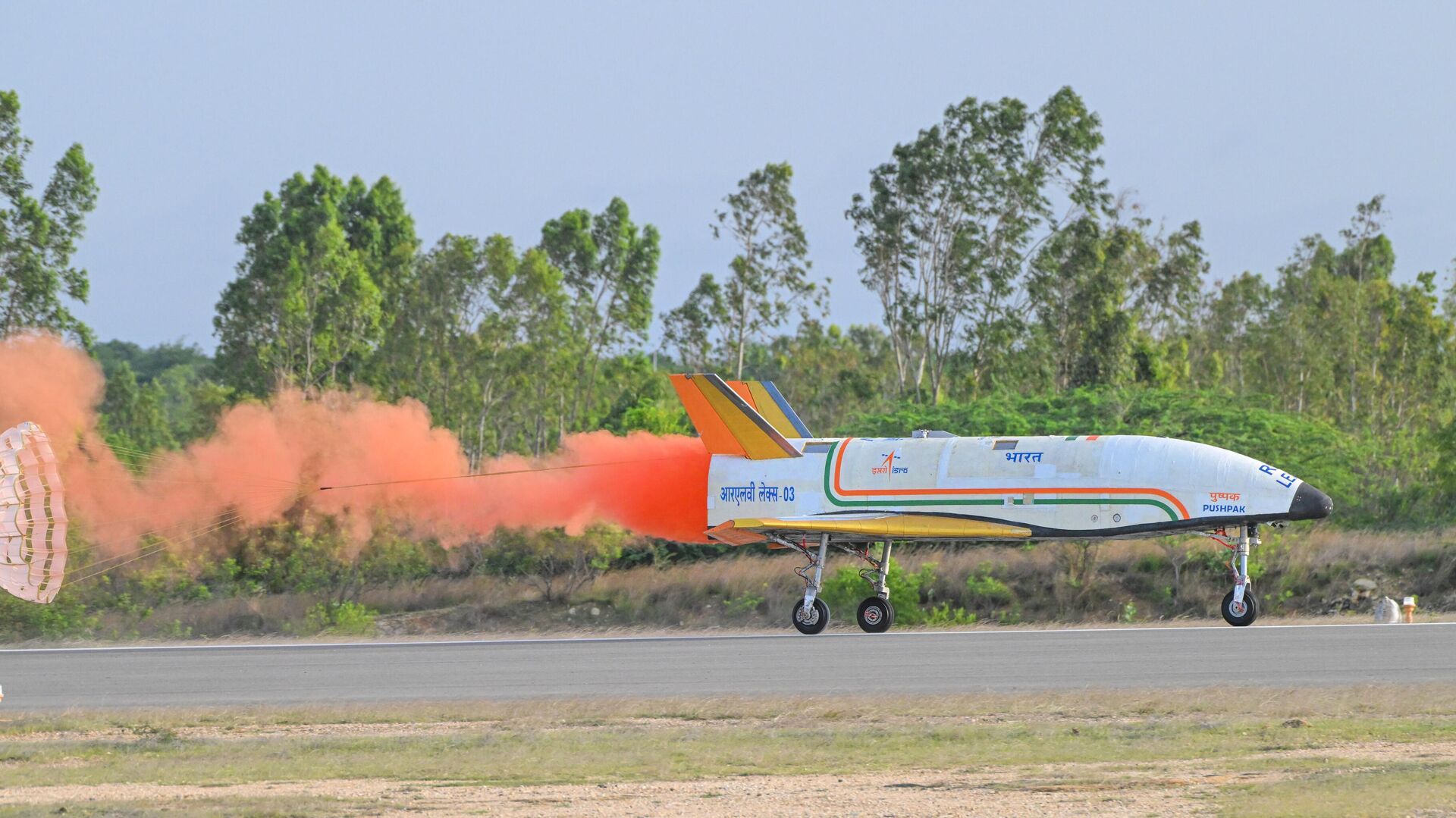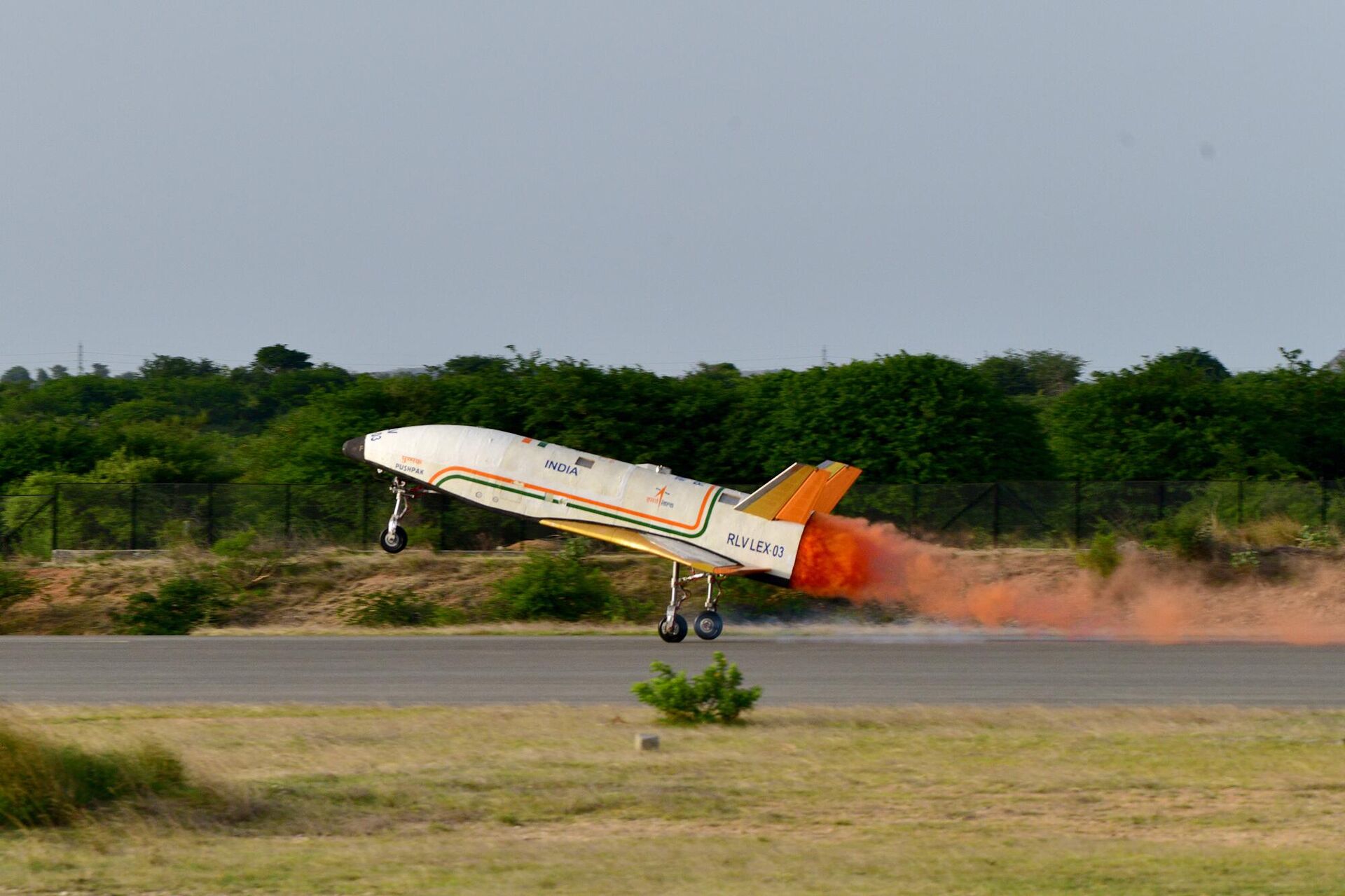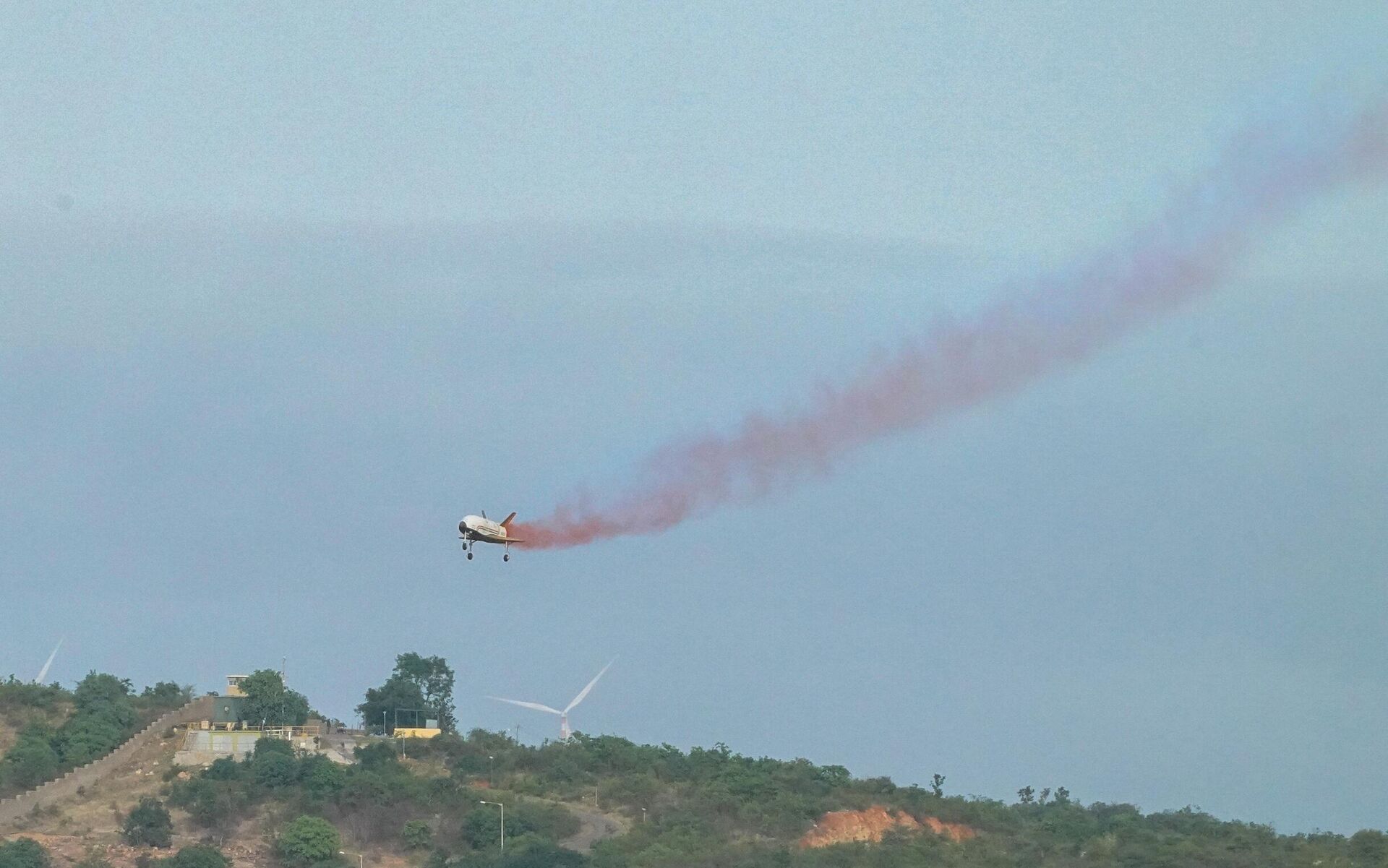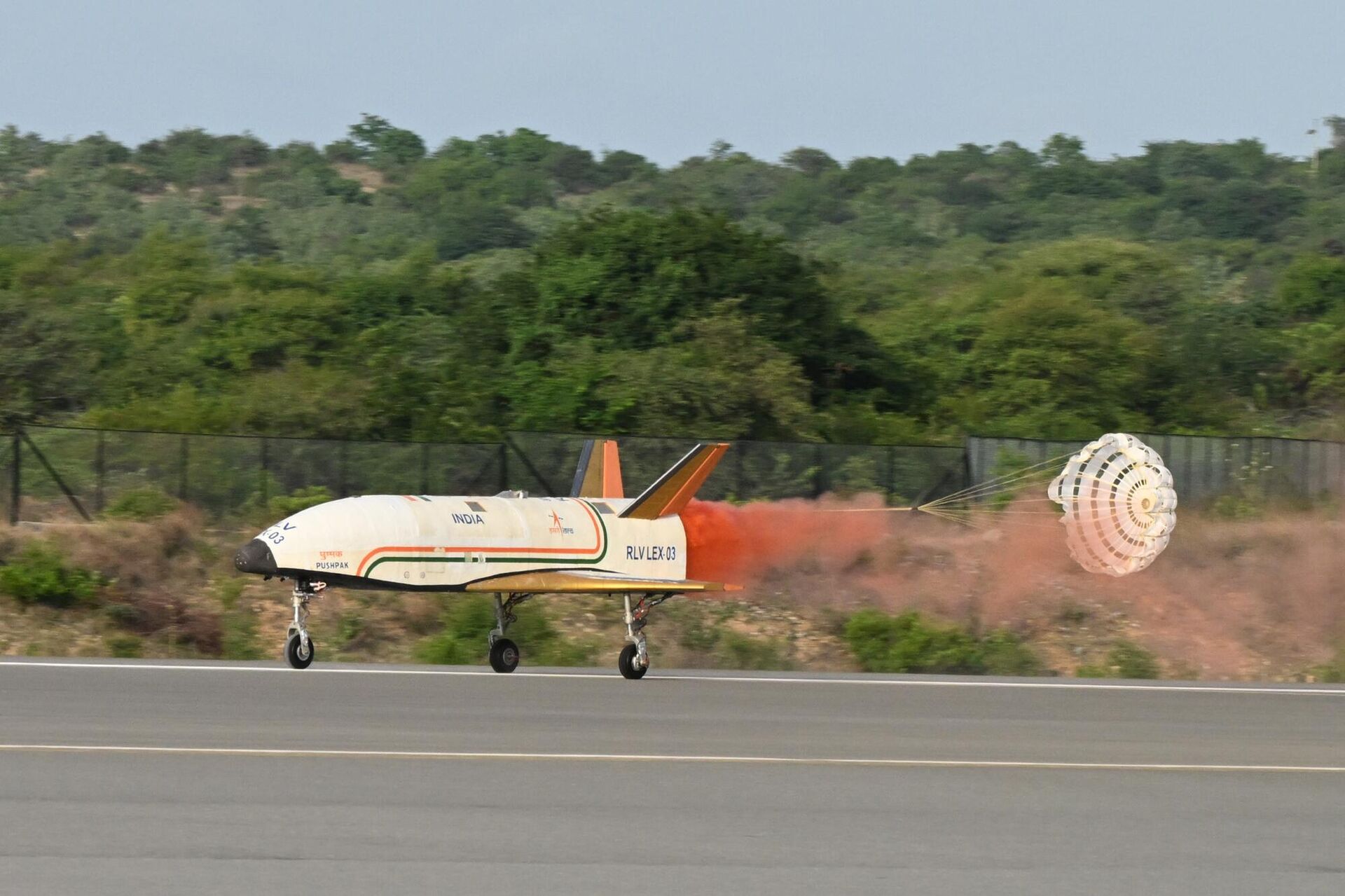https://sputniknews.in/20240711/isros-pushpak-indias-reusable-analogue-of-us-air-forces-x-37b-7826409.html
ISRO's Pushpak: India's Reusable Analogue of US Air Force's X-37B
ISRO's Pushpak: India's Reusable Analogue of US Air Force's X-37B
Sputnik India
Pushpak spacecraft, a scale model of which recently demonstrated its autonomous landing capability, would be developed as an unmanned reusable spacecraft that... 11.07.2024, Sputnik India
2024-07-11T17:32+0530
2024-07-11T17:32+0530
2024-07-11T17:32+0530
sputnik opinion
indian space research organisation (isro)
us
science & tech
india
bay of bengal
indian air force (iaf)
elon musk
polar satellite launch vehicle (pslv)
space industry
https://cdn1.img.sputniknews.in/img/07e8/07/0b/7828475_320:0:3961:2048_1920x0_80_0_0_b8de4594b1cbecd8c0c4f299d5f103c4.jpg
So far, ISRO has developed the Pushpak as RLV-TD (Reusable Launch Vehicle – Technology Demonstrator) for validating technologies required to implement TSTO (two stage to orbit) launch architecture.The RLV was originally conceived as a LEO (Low Earth Orbit) launcher with 15 times re-usability. It was expected to reduce launch cost by approximately 50 – 60% when compared to an expendable launch vehicle.As the Pushpak, the RLV-TD will not be developed as a launcher; but as a reusable spacecraft for placing and retrieving payloads in orbit.In its new incarnation, ISRO's reusable launch vehicle will perform a role similar to the US X-37B Unmanned Reusable Spacecraft.When fully realised, the Pushpak will represent a technological leap.X-37BThe X-37B is a super secretive unmanned spacecraft, which was first launched in 2010.Besides reusability and autonomous recovery, other outstanding capabilities of the X-37B include orbital manoeuvrability, ability to carry different payloads on different missions and extended mission duration.The X-37B is currently the only spacecraft in the world that can be repeatedly flown into orbit for short or long duration and then recovered. The winged spacecraft, which is launched into orbit conventionally on a multi-stage stacked launcher, is capable of autonomously deorbiting and gliding back to base and landing like an aircraft.The secrecy shrouding the X-37B program is on account of its offensive military capabilities and its potential counter space abilities.ISRO's Approach to Space Hardware ReusabilityTo begin with, ISRO's approach to space hardware reusability focused largely on winged launchers that could fly or glide back and land on runways. Retrieving a launch stage through retro burns of the main engine, followed by a vertical landing of the stage was considered technologically too challenging.In early 2000, ISRO commenced work on SSTO (Single-stage-to-Orbit) and TSTO concepts based on reusable launch vehicles. ISRO's pursuit of reusability was motivated by a desire to reduce the cost of access to space, from around $5,000 / kg to around $500 / kg. At that point of time, ISRO was not clear on the architecture best suited to achieve reusability.SSTOISRO's SSTO concept was based on a reusable vehicle called AVATAR, powered by a combination of semi-cryogenic and scramjet engines. The semi-cryogenic engine would be used for lift off and orbital insertion, the scramjet, for climbing through the atmosphere up to an altitude of 50 km.AVATAR, which involved challenges in engine and material development, was conceived as a long term project.TSTOThe TSTO concept involved using a first stage powered by a semi cryogenic winged booster. Following burnout, the stage would fly back and land on a runway near the launch site, like a conventional aircraft.A cryogenic second stage would deliver the satellite into orbit, de-orbit and re-enter the atmosphere and parachute down to a soft landing on balloons.ISRO aimed to realise the TSTO concept first, because it involved technology that ISRO was confident of implementing.RLV-TDIn pursuit of TSTO, ISRO first unveiled its RLV-TD concept at Aero India 2009.ISRO's RLV-TD project was to serve as a flying test bed to evaluate various technologies, such as hypersonic flight, autonomous landing, powered cruise flight and hypersonic flight using air-breathing propulsion.The project was to be implemented in three phases through a series of trial flights.The first in the series of trials was the HEX (hypersonic flight experiment), followed by the LEX (landing experiment), REX (return flight experiment) and SPEX (scramjet propulsion experiment).HEX MissionAs part of the HEX mission, a 1.5 tonne RLV 1/6 scale model was to be boosted to 70-km altitude and released. A single strap-on solid fueled booster of the PSLV (Polar Satellite Launch Vehicle) with 9 tonne fuel would be used as the booster.The lofted RLV was to re-enter the atmosphere travelling at around 2-km / sec. The descent speed would be controlled using the fins. Protective tiles on the RLV would dissipate frictional heat during re-entry. The vehicle would perform a controlled splashdown in the sea.LEX MissionIn the second phase, the RLV-TD was to be tested without its scramjet engine. After burnout, the booster was to separate and fall away, and the RLV-TD was to go on to make an unpowered ascent.The RLV-TD would then re-enter the atmosphere at hypersonic speed and use aerodynamic braking to decelerate. It would perform a range manoeuvre at 15-km altitude, a 2g turn towards its launch site. Once the TD reaches 0.8 M, it would light up a turbofan engine to cruise back to its launch site at 0.6 M and make a horizontal landing on a runway.REX MissionDuring this mission, the RLV-TD would be launched to orbit and then deorbited for a landing on a runway.SPEX MissionISRO is developing an air breathing scramjet engine under a separate project called ABPP (Air Breathing Propulsion Project).However, integrating scramjet propulsion with a conventional launcher stack poses extreme challenges. ISRO itself harbours doubts over the practicality of such a launcher stack.HEX Mission SuccessOn 23 May 2016, ISRO successfully conducted the HEX mission, flight testing India’s first winged body aerospace vehicle operating in hypersonic flight regime.The HS9 solid rocket booster carrying RLV-TD lifted off from Satish Dhawan Space Center, Sriharikota. After a successful flight of 91.1 sec, HS9 burn out occurred, following which both HS9 and RLV-TD mounted on its top coasted to a height of about 56 km. At that height, RLV-TD separated from the HS9 booster and further ascended to a height of about 65 km.The RLV-TD then began its descent followed by atmospheric re-entry at around Mach 5.The Pushpak's navigation, guidance and control systems accurately steered the vehicle during the critical atmospheric re-entry phase, using thrusters. The TPS (Thermal Protection System) helped the spacecraft survive the extreme heat. The RLV-TD successfully glided down to the defined landing spot over Bay of Bengal, at a distance of about 450-km from Sriharikota. Total flight duration from launch to landing of the mission was about 770-sec.The Path AheadISRO itself admits that at this stage, the only thing clear about the RLV program is the need to reduce launch costs.In June 2016 ISRO Chairman A.S. Kiran Kumar was asked about, what the ultimate objective of a winged configuration would be?"Right now we are clear about one of the objectives: we want to bring down the costs," he replied.Revised TSTO ConceptFollowing the success of Elon Musk's SpaceX in mastering the technology to recover launch stages vertically through retro burns, ISRO started to revise its reusability concepts.In January 2019, ISRO Chairman K. Sivan presented a revised TSTO re-usability architecture.The engineer added, that once it injects the satellite in its orbit, the shuttle will glide back to the earth and land on an airstrip like an aircraft. However, he mentioned, that the second stage recovery has never been tried by any other space agency in the world, including SpaceX.LEX Mission ProgressFollowing the success of HEX, ISRO embarked on the RLV-LEX phase. The initial focus of RLV-LEX is to demonstrate the ability of a scaled down RLV-TD, which is now referred to as Pushpak, to autonomously control its flight path, following reentry into the Earth's atmosphere, and land on a runway.Early morning on April 2, 2023, as part of RLV-LEX-01, an IAF (Indian Air Force) Chinook helicopter released the launch vehicle at a height of 4.5 km, while displaced 4.6 km away from the runway at the Chitradurga Aeronautical Test Range. The Pushpak "performed approach and landing manoeuvres using Integrated Navigation, Guidance, and control system and completed an autonomous landing on the airstrip."During a follow-up helicopter drop test on March 22, 2024, RLV LEX-02 demonstrated the vehicle's ability to autonomously land under non-standard launch conditions. The vehicle performed complex manoeuvres to adjust both lateral deviation and range and successfully landed on Chitradurga runway.More tests similar to RLV-LEX-01 & RLV-LEX-02 are planned to be conducted to test other conditions like wind, different failure conditions and other factors.Pushpak Will Demonstrate Spacecraft UsabilityThe ISRO chief elaborated that the vehicle can take payloads back and forth. "The payload is more valuable than the rocket itself and because of that it is cost-effective. If deploying a satellite using Pushpak is not cost-effective, then you can use SSLV, PSLV, LMV-3 or GSLV. Using the reusable launch vehicle the endeavour would be to send a payload to conduct experiments in orbit and bring it back then it has a lot of value," he highlighted.Unique CapabilitiesA reusable spacecraft like the ISRO's Pushpak could perform diverse scientific or military roles, well beyond the capabilities of ordinary satellites.The military roles would leverage the ability of the vehicle to use its thrusters to change orbit to inspect adversary spacecraft. It could even damage or destroy adversary satellites.A full discussion on the possible use of a Pushpak-like spacecraft is beyond the scope of this article.ConclusionHaving realised the technology associated with autonomous recovery and runway landing of unmanned winged reusable spacecraft, ISRO has chosen to de-emphasise the launch capability of the Pushpak in favour of its ability to place and recover payloads in orbit.ISRO appears set on developing the launch vehicle as a X-37B analog, not a US space shuttle analog, which featured formidable launch capability.Some obvious advantages of going for a low hanging fruit include a predictable development time frame and lowered risk. In the case of the Pushpak, the payoffs also would be very substantial as discussed above and in the context of ISRO's manned spaceflight program.
us
india
bay of bengal
Sputnik India
feedback.hindi@sputniknews.com
+74956456601
MIA „Rossiya Segodnya“
2024
News
en_IN
Sputnik India
feedback.hindi@sputniknews.com
+74956456601
MIA „Rossiya Segodnya“
Sputnik India
feedback.hindi@sputniknews.com
+74956456601
MIA „Rossiya Segodnya“
indian space research organisation (isro) , us, science & tech, india, bay of bengal, indian air force (iaf), elon musk, polar satellite launch vehicle (pslv), space industry
indian space research organisation (isro) , us, science & tech, india, bay of bengal, indian air force (iaf), elon musk, polar satellite launch vehicle (pslv), space industry
ISRO's Pushpak: India's Reusable Analogue of US Air Force's X-37B
Pushpak spacecraft, a scale model of which recently demonstrated its autonomous landing capability, would be developed as an unmanned reusable spacecraft that would use a three stage to orbit architecture, the ISRO's chairman S. Somanath told NDTV in June.
So far, ISRO has developed the Pushpak as RLV-TD (Reusable Launch Vehicle – Technology Demonstrator) for validating technologies required to implement TSTO (two stage to orbit) launch architecture.
The RLV was originally conceived as a LEO (Low Earth Orbit) launcher with 15 times re-usability. It was expected to reduce launch cost by approximately 50 – 60% when compared to an expendable launch vehicle.
As the Pushpak, the RLV-TD will not be developed as a launcher; but as a reusable spacecraft for placing and retrieving payloads in orbit.
In its new incarnation, ISRO's reusable launch vehicle will perform a role similar to the US X-37B Unmanned Reusable Spacecraft.
When fully realised, the Pushpak will represent a technological leap.
The X-37B is a super secretive unmanned spacecraft, which was first launched in 2010.
Besides reusability and autonomous recovery, other outstanding capabilities of the X-37B include orbital manoeuvrability, ability to carry different payloads on different missions and extended mission duration.
The current record for the spacecraft is 780 days — more than two full years — in orbit, which occurred during the fifth flight of the X-37B.
The X-37B is currently the only spacecraft in the world that can be repeatedly flown into orbit for short or long duration and then recovered. The winged spacecraft, which is launched into orbit conventionally on a multi-stage stacked launcher, is capable of autonomously deorbiting and gliding back to base and landing like an aircraft.
The secrecy shrouding the X-37B program is on account of its offensive military capabilities and its potential counter space abilities.
ISRO's Approach to Space Hardware Reusability
To begin with, ISRO's approach to space hardware reusability focused largely on winged launchers that could fly or glide back and land on runways. Retrieving a launch stage through retro burns of the main engine, followed by a vertical landing of the stage was considered technologically too challenging.
In early 2000, ISRO commenced work on SSTO (Single-stage-to-Orbit) and TSTO concepts based on reusable launch vehicles. ISRO's pursuit of reusability was motivated by a desire to reduce the cost of access to space, from around $5,000 / kg to around $500 / kg. At that point of time, ISRO was not clear on the architecture best suited to achieve reusability.
Besides reduced costs, ISRO was also motivated by a desire to reduce space debris strewn by non reusable launchers, thereby reducing the danger posed to spacecraft in orbit by such debris.
ISRO's SSTO concept was based on a reusable vehicle called AVATAR, powered by a combination of semi-cryogenic and scramjet engines. The semi-cryogenic engine would be used for lift off and orbital insertion, the scramjet, for climbing through the atmosphere up to an altitude of 50 km.
AVATAR, which involved challenges in engine and material development, was conceived as a long term project.
The TSTO concept involved using a first stage powered by a semi cryogenic winged booster. Following burnout, the stage would fly back and land on a runway near the launch site, like a conventional aircraft.
A cryogenic second stage would deliver the satellite into orbit, de-orbit and re-enter the atmosphere and parachute down to a soft landing on balloons.
ISRO aimed to realise the TSTO concept first, because it involved technology that ISRO was confident of implementing.
In pursuit of TSTO, ISRO first unveiled its RLV-TD concept at Aero India 2009.
ISRO's RLV-TD project was to serve as a flying test bed to evaluate various technologies, such as hypersonic flight, autonomous landing, powered cruise flight and hypersonic flight using air-breathing propulsion.
The project was to be implemented in three phases through a series of trial flights.
The first in the series of trials was the HEX (hypersonic flight experiment), followed by the LEX (landing experiment), REX (return flight experiment) and SPEX (scramjet propulsion experiment).
As part of the HEX mission, a 1.5 tonne RLV 1/6 scale model was to be boosted to 70-km altitude and released. A single strap-on solid fueled booster of the PSLV (Polar Satellite Launch Vehicle) with 9 tonne fuel would be used as the booster.
The lofted RLV was to re-enter the atmosphere travelling at around 2-km / sec. The descent speed would be controlled using the fins. Protective tiles on the RLV would dissipate frictional heat during re-entry. The vehicle would perform a controlled splashdown in the sea.
In the second phase, the RLV-TD was to be tested without its scramjet engine. After burnout, the booster was to separate and fall away, and the RLV-TD was to go on to make an unpowered ascent.
The RLV-TD would then re-enter the atmosphere at hypersonic speed and use aerodynamic braking to decelerate. It would perform a range manoeuvre at 15-km altitude, a 2g turn towards its launch site. Once the TD reaches 0.8 M, it would light up a turbofan engine to cruise back to its launch site at 0.6 M and make a horizontal landing on a runway.
During this mission, the RLV-TD would be launched to orbit and then deorbited for a landing on a runway.
ISRO is developing an air breathing scramjet engine under a separate project called ABPP (Air Breathing Propulsion Project).
However, integrating scramjet propulsion with a conventional launcher stack poses extreme challenges. ISRO itself harbours doubts over the practicality of such a launcher stack.
On 23 May 2016, ISRO successfully conducted the HEX mission, flight testing India’s first winged body aerospace vehicle operating in hypersonic flight regime.
The HS9 solid rocket booster carrying RLV-TD lifted off from Satish Dhawan Space Center, Sriharikota. After a successful flight of 91.1 sec, HS9 burn out occurred, following which both HS9 and RLV-TD mounted on its top coasted to a height of about 56 km. At that height, RLV-TD separated from the HS9 booster and further ascended to a height of about 65 km.
The RLV-TD then began its descent followed by atmospheric re-entry at around Mach 5.
The Pushpak's navigation, guidance and control systems accurately steered the vehicle during the critical atmospheric re-entry phase, using thrusters. The TPS (Thermal Protection System) helped the spacecraft survive the extreme heat. The RLV-TD successfully glided down to the defined landing spot over Bay of Bengal, at a distance of about 450-km from Sriharikota. Total flight duration from launch to landing of the mission was about 770-sec.
ISRO itself admits that at this stage, the only thing clear about the RLV program is the need to reduce launch costs.
In June 2016 ISRO Chairman A.S. Kiran Kumar was asked about, what the ultimate objective of a winged configuration would be?
"Right now we are clear about one of the objectives: we want to bring down the costs," he replied.
Following the success of Elon Musk's SpaceX in mastering the technology to recover launch stages vertically through retro burns, ISRO started to revise its reusability concepts.
In January 2019, ISRO Chairman K. Sivan presented a revised TSTO re-usability architecture.
"We are working on a reusable launch technology in order to recover the first and second stages of a rocket so that we can reuse them to cut cost and carry heavier payloads. The first rocket stage will be recovered on a vertical landing spot on the sea like SpaceX has been doing with its Falcon rocket. However, recovering the second stage is not simple," he stated. "We are, therefore, developing a winged body like a space shuttle, which will be attached as a second stage in a rocket. It will carry the top portion of the rocket comprising a satellite or spacecraft to space."
The engineer added, that once it injects the satellite in its orbit, the shuttle will glide back to the earth and land on an airstrip like an aircraft. However, he mentioned, that the second stage recovery has never been tried by any other space agency in the world, including SpaceX.
Following the success of HEX, ISRO embarked on the RLV-LEX phase. The initial focus of RLV-LEX is to demonstrate the ability of a scaled down RLV-TD, which is now referred to as Pushpak, to autonomously control its flight path, following reentry into the Earth's atmosphere, and land on a runway.
Early morning on April 2, 2023, as part of RLV-LEX-01, an IAF (Indian Air Force) Chinook helicopter released the launch vehicle at a height of 4.5 km, while displaced 4.6 km away from the runway at the Chitradurga Aeronautical Test Range. The Pushpak "performed approach and landing manoeuvres using Integrated Navigation, Guidance, and control system and completed an autonomous landing on the airstrip."
During a follow-up helicopter drop test on March 22, 2024, RLV LEX-02 demonstrated the vehicle's ability to autonomously land under non-standard launch conditions. The vehicle performed complex manoeuvres to adjust both lateral deviation and range and successfully landed on Chitradurga runway.
More tests similar to RLV-LEX-01 & RLV-LEX-02 are planned to be conducted to test other conditions like wind, different failure conditions and other factors.
Pushpak Will Demonstrate Spacecraft Usability
"The first phase of Pushpak's scaled-down version is over, with three successful safe landings, we are in the process of building a bigger version, which would be 1.6 times the scaled-down model. It will be tested on similar lines with landing first and it will be launched through a rocket to orbit. The focus has shifted there now," ISRO chairman S. Somanath told NDTV, while announcing the aims of the Pushpak program in June 2024.
The ISRO chief elaborated that the vehicle can take payloads back and forth.
"The payload is more valuable than the rocket itself and because of that it is cost-effective. If deploying a satellite using Pushpak is not cost-effective, then you can use SSLV, PSLV, LMV-3 or GSLV. Using the reusable launch vehicle the endeavour would be to send a payload to conduct experiments in orbit and bring it back then it has a lot of value," he highlighted.
A reusable spacecraft like the ISRO's Pushpak could perform diverse scientific or military roles, well beyond the capabilities of ordinary satellites.
The military roles would leverage the ability of the vehicle to use its thrusters to change orbit to inspect adversary spacecraft. It could even damage or destroy adversary satellites.
A full discussion on the possible use of a Pushpak-like spacecraft is beyond the scope of this article.
Having realised the technology associated with autonomous recovery and runway landing of unmanned winged reusable spacecraft, ISRO has chosen to de-emphasise the launch capability of the Pushpak in favour of its ability to place and recover payloads in orbit.
ISRO appears set on developing the launch vehicle as a X-37B analog, not a US space shuttle analog, which featured formidable launch capability.
Some obvious advantages of going for a low hanging fruit include a predictable development time frame and lowered risk. In the case of the Pushpak, the payoffs also would be very substantial as discussed above and in the context of ISRO's manned spaceflight program.




